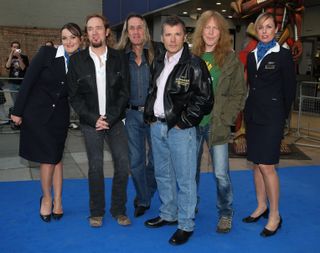“They think they’re better than you? Fuck ’em. They have something you want? Fuck ’em. They’ve put something in your way? Fuck. Them. It’s about reality, honesty, integrity, it’s about working hard to earn your crust, and you do not compromise.”
Iron Maiden manager Rod Smallwood is expounding upon the fundamentals of rugby. There’s a Six Nations match tomorrow, and conversation has shifted from the legendary Yorkshireman’s fi rst love – Iron Maiden – to his second. Or has it?
“No, not at all,” he smiles. “It’s the same thing. We never had help in the beginning, no one was on our side. Iron Maiden approached their career in the same way.”
It’s not an assessment you can argue with. Nearly 34 years have passed since the band’s conception by Steve Harris on Xmas Day, 1975, and – at a stage when even the hardiest of bands are in their twilight, Iron Maiden are due to release one of the greatest documents to their ongoing defi ance of conventional wisdom: Iron Maiden: Flight 666 – a tour documentary that covers the first leg of their genuinely world-beating Somewhere Back In Time world tour last year. The colossal nature of that tour’s first chapter is an essay unto itself, so let’s stick to the numbers: 21 cities across three continents, 50,000 miles, and the not insignificant matter of Ed Force One, the band’s own plane, piloted by Bruce Dickinson himself. As global victory laps go, it aimed two gigantic fingers squarely at the naysayers who have dismissively shook their heads at a band with a zombie for a mascot and lyrics that have more to do with Homeric epics and Western culture’s fixation with heroic feats than fashion.
“It’s like when we started. Go back to 1979, my plan was: ‘We’ve got the East End, let’s get London; we’ve got London, let’s get England; we’ve got England…’ It’s easier now because communication is global, but there was no metal press back in those days so we had to do it in a totally different way, but our belief was: there were people out there who were not satisfied and they wanted something more.”
…Flight 666 is as much a documentary about the commitment of Maiden fans around the world as it is a testament to the band’s undiminished ability to enthrall on the live stage. It was assembled from over 500 hours of footage by Canadian filmmaking duo Sam Dunn and Scott McFadyen, the pair responsible for 2005’s rapturously received Metal: A Headbanger’s Journey – where the duo’s relationship with Maiden began.
“They contacted me because they were having trouble accessing people, and when I realised Sam was a professor of anthropology I realised they wanted to take an intelligent approach, and that’s what I wanted,” says Rod. “Metal people are genuinely bright people. Metal to the media world is looked on like this gormless, slovenly form of music, which we all know is completely bullshit. Metal is an outlet. Frustration is built up from questioning. If you’re questioning, there’s innate intelligence. So to me metal fans have always been very intelligent. So I thought I should encourage these and I arranged some interviews with Tony Iommi, Slayer, and people like that. They came to me a couple of years ago when we announced the Maiden tour, and they said they wanted to do a documentary on Maiden. I was like, ‘OK, but what’s the story?’”

Therein lies the conundrum. As Rod points out, there’s no blackness to Maiden – no underbelly requiring exposure and, therefore, no obvious angle for a documentary film. That is, of course, if you overlook the sentiment that Steve Harris so eloquently expressed in these very pages last year on the eve of Maiden’s triumphant appearance at Twickenham Stadium: “I hope that Maiden fans can feel a sense of accomplishment in seeing us play here because they have been a part of the journey.”
…Flight 666 is in some ways two films running in parallel: in equal parts a record of what life on the road in the biggest metal band in the world is like as it is an answer to the question of how it’s possible that an English metal band can inspire fanatical adoration from Tokyo to Mumbai to Bogota, and – not insignificantly – sell out stadiums. In some parts it’s a curiosity cabinet – meeting the Catholic priest in Brazil festooned with Maiden tattoos from tit to fingertip whose sermons are based on Maiden lyrics; Nicko McBrain receiving an Aztec blessing in Mexico. In others, it’s a fly on the wall’s view of life with Steve Harris and company – a bird’s eye view of Ed Force One’s Maiden voyage, and in others, a sentimental tribute not just to what Maiden represents around the world but what metal represents.
Take the Colombian metal fan, one of tens of thousands who camped outside Simon Bolivar Park for nine days in a tent city, who authorities stripped of food and water before being allowed in, who – upon catching one of Nicko McBrain’s drumsticks tossed into the crowd, completely loses his shit. Or take the kid on his way to Maiden’s show in Mumbai who – in a universally repeated tradition of Maiden supporters – relates the day that he became a fan. Like millions of others, he admits that it was the artwork he saw and was captivated by at first, and when he actually heard the band, ‘It was love at first listen.’ It’s these moments – a shift of the camera away from the main attraction – that makes this so compelling.
“If you made a documentary without the fans it’d be a farce, a fake, a sham,” says Sam Dunn, fresh from relating the story of his first encounter with Maiden. He was 12, he’d just seen some artwork, and precisely one listen to Powerslave on a school record player, well… you know the rest.
“A lot of films get made without a single meaningful shot of the fans. That’s different with the Maiden experience. You couldn’t capture those shows without the singalongs. Go to South America and kids are singing the harmonies and the solos obsessively, not just the words. But what pisses me off is you can make six documentaries about the Rolling Stones, like Shine A Light, celebrating the band and only the band, and you make a movie about Iron Maiden and people scratch their heads and ask ‘Why?’
Take the fan in Chile who’s about to see Iron Maiden for the first time – a full 20 years since the time the band first came to that country only to be banned as the result of protests by the Catholic Church. Or the fan in Mexico City who tells the camera that his country is ‘the ass of the world’ and no one goes there, but then Maiden do. It’s all in stark contrast to the glitz of the first dates of the tour back in LA, with the likes of Lars Ulrich, Scott Ian, Tom Morello and Kerry King lurking in the backstage halls of power waiting for a glimpse of a band that, to the amazement of many in a business accustomed to separate tour buses (and in some cases, jets), still share the same dressing room. But when the band depart for the Southern hemisphere, there’s a deep sense that they’re leaving both the relative security and familiarity of their usual stomping grounds and putting themselves in harm’s way. The fi lm takes a distinctly dark turn, as if… they’re entering Mordor. Sam doesn’t disagree.

“Yeah, it’s scary, but it turns out Mordor’s the place to be!” he says, radiating a love for his subject. “There’s a volatility down there and overall enthusiasm that can tip over into being dangerous or risky, but I think the guys in the band know there’s always something that could happen so there’s this urgency and tension for the second half of the tour. But there’s something Bruce says about trying to feel worthy of those crowds’ energy that sums it up. They’re playing most of these places for the first time and selling them out.
“I mean, we always felt like you could walk through a crowd, but it’s not what we’re used to. In Colombia there’s the threat of rebels, kidnappings, but then you’ve got the military people throwing you the horns too. It’s a weird scenario. Every person in Bogota had to take their shoes off and put them back on – some of the kids just ran in without them to get to the front of the stage before anyone else.”
The question of how to capture the religious fervour of Maiden fans around the world wasn’t the only challenge Sam and Scott faced. First, they had to penetrate Maiden’s inner circle, a tight-knit web of long-serving roadies and managers who conduct the business of touring with military precision.
“Maiden are a highly functional band,” says Scott. “They’re in their 50s playing some of the most challenging, energetic music around. It flies in the face of the idea that heavy metal should just be played by young people, but then they’re difficult to know. It was hard in the beginning.”
They relate how the first two weeks left them feeling like outsiders, and it was a while before going along with drummer Nicko McBrain for off-day jaunts of golf or Adrian Smith for tennis. As time went on, endearing themselves with the bandmates’ wives worked wonders. And it’s with each chapter of this story – punctuated by another number from the …Back In Time tour’s career-spanning setlist, that the pair seem to enter what Sam describes as a circle of trust.
“Different people had different takes,” he says. “Janick hated being filmed, but then he came around. When you’re part of the family, you’re part of the family, but we got put through the ringer by the crew. They’re not used to it: media and cameras are bad. That’s a problem. And with 70 people all thinking the same thing, and you’re trying get them all to like you? It’s like going back to high school!”
Of course, sharing the moment of departure in the cockpit of Ed Force One, climbing above the clouds in a jet piloted by Bruce Dickinson, and filming it, is not an experience to be sniffed at. But then, as Sam admits, it’s not about the personal privilege of that vantage point, it’s about sharing that experience with the tens of millions of fans worldwide for whom upping the Irons is a way of life. There’s a reason why they relate.
As Rod Smallwood says: “The band never asked me how many tickets we sold. They want to play and they know they’re going to play to devoted fans. 500 or 50,000, it doesn’t matter that much. A lot of bands trundle around between arenas and stadiums and no one wants to be on stage; for them it’s a job, it’s not passion. You should do things for the right reasons. And we do.”
This article originally appeared in Metal Hammer #190.
To find out how Maiden created their latest world-beating double album, then click on the link below.
TeamRock+ Exclusive: Iron Maiden – How We Made The Book Of Souls


